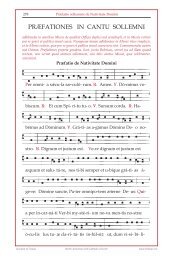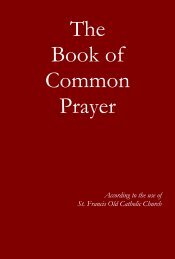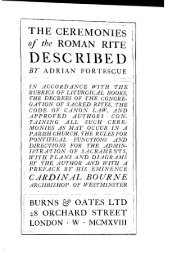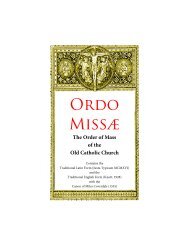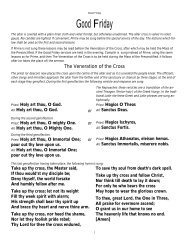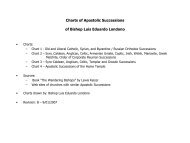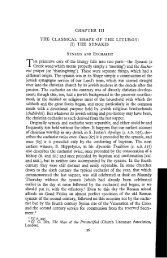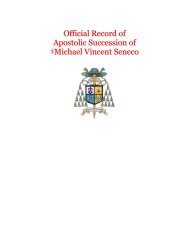Eucharist and Lord's Supper
Eucharist and Lord's Supper
Eucharist and Lord's Supper
You also want an ePaper? Increase the reach of your titles
YUMPU automatically turns print PDFs into web optimized ePapers that Google loves.
EUCHARIST AND LORD'S SUPPER 95<br />
gether, just as the laity, met at the <strong>Lord's</strong> supper without a cleric,are bidden<br />
to do by Hippolytus a century before. What is interesting is to find the<br />
whole technical terminology of the liturgical eucharist, 'eucharistising',<br />
'hallowing', 'We give thanks unto Thee .. .', 'breaking the bread', 'the<br />
bread set forth' (prokeimenon-the regular word for the liturgical oblation)<br />
-still unhesitatingly applied to this obviously purely domestic meal of<br />
women alone, in the fourth century when there can be no question of any<br />
confusion of ideas between agape <strong>and</strong> eucharist. It is a warning not to<br />
build theories on the 'eucharistic' terminology applied to the agape in<br />
earlier documents.<br />
We are now in a position to come to our conclusions about the <strong>Lord's</strong><br />
supper or agape, <strong>and</strong> its relation to the eucharist. There is no evidence<br />
whatever that these are really parallel developments of the same thing, a<br />
'Jerusalem type' of non-sacramental fellowship meal, <strong>and</strong> a 'Pauline type'<br />
of eucharistic oblation, as Lietzmann <strong>and</strong> others have supposed. Both<br />
derive from the chabi'trah supper. But the eucharist consists of those two<br />
elements in the chabi'trah customs to which our Lord Himself at the last<br />
supper had attached a new meaning for the future with reference to His<br />
own death. These have been carefully extracted from their setting, <strong>and</strong><br />
continued in use apart from the rest of the chabi'trah meal for obvious<br />
reasons. The <strong>Lord's</strong> supper or agape consists precisely of what was left of<br />
the chabi'trah meal when the eucharist had been removed. In fact we may<br />
say that while the eucharist was derived directly from the last supper <strong>and</strong><br />
from nothing else, the agape derived really from the previousmeetings of<br />
our <strong>Lord's</strong> chabi'trah before the last supper, though the separation between<br />
them wasnot made in practice before a generation had passed. And just as<br />
the berakah at the end of the supper, the only prayer of the jewish rite<br />
which was transferred to the new christian rite, furnished it with its new<br />
name by direct translation into Greek as eucharistia, so what was left of<br />
the supper seems to have furnished the Greek name of the <strong>Lord's</strong><br />
supper. Dr. Oesterley seems justified in his suggestion 'that the name<br />
Agape was intended as a Greek equivalent to the neo-Hebrew Chabi'trah<br />
... which means "fellowship", almost "love".'!<br />
The permanent mark of the separation of the two rites was the complete<br />
absence of the 'cup of blessing' <strong>and</strong> the accompanying berakah from all<br />
known forms of the <strong>Lord's</strong> supper or agape. In this the christian continuation<br />
of the chabi'trah supper differed notably from its jewish parent, where<br />
these two things were the central point <strong>and</strong> formal characteristic of a<br />
chabi'trah meeting. The transference of just those two elements in the supper<br />
ritual to which our Lord had assigned a new meaning connected with<br />
His own death to a new <strong>and</strong> separate rite is in itself a strong indication of<br />
the way in which the liturgical eucharist was regarded by those who first<br />
made the separation. This is especially striking when we consider the<br />
1 Jewish Background of the Christian Sacraments, p. 204.



